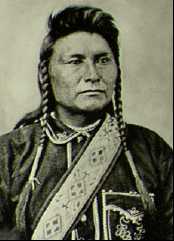A Common History of Assyrians and Native Americans
By Benjamin Daniali
Where did Chief Joseph get a cuniform tablet?
(Park, Edwards; "Where Did Chief Joseph Get a Cuneiform Tablet?" Smithsonian Magazine, 9:36, February 1979)
(Red Earth, White Lies by Vine Delora Jr., page 48)
History mystery: Chief Joseph's cuneiform tablet
By Mary Gindling
There are several puzzling things about Chief Joseph's tablet. Cuneiform tablets were still relatively rare in 1877, especially in the American West. It is highly unlikely that some acquaintance of the Nez Perce chief would have had such an object to begin with and, if so, Joseph certainly would have said so. Chief Joseph was a man of honor. He would have had little to gain by saying that his family had possessed the tablet for many generations if, in fact, he had gotten it from some missionary or trader.
The mundane nature of the contents of the tablet argues against forgery. Cuneiform had only been deciphered in 1846 and the process was far from complete even in 1877, so a would-be forger would have had to be an extremely well educated individual familiar not only with the ancient language itself, but with the shape of the tablets created by the ancient scribes.
1) I don't think the Assyrians in northern Iraq had ocean-going vessels. The Phoenicians did, but I'm not sure their ships were sturdy enough to cross the Atlantic. And Phoenicians would've used Phoenician writing, not Assyrian writing.
2) An Assyrian could've passed the tablet to anyone in Europe, Asia, or Africa. It's ridiculous to claim a single Assyrian tablet proves the presence of Assyrians.
3) The tablet's nature (an inch-square receipt for a lamb) suggests it was a souvenir, not a working document. If you're crossing the ocean for some reason, do you carry a receipt for a lamb you bought several years ago? It sounds exactly like something you'd buy in a curio shop: a mysterious talisman from the exotic "Orient."
The tablet explained
So where did the tablet come from? Chief Joseph supposedly said that "white men had come among his ancestors long ago." Even if that were true, consider a few early visits by white men:
Awesome America--Oregon
Even the Lewis and Clark expedition, supposedly the first white men to visit the Northwest over land, happened a couple of generations before Chief Joseph's birth. One of them, or one of the fur trappers who followed, could've given the tablet to, say, Chief Joseph's grandparents. It's easy to imagine their telling young Joseph about the white men who came among his ancestors long ago. They could've exaggerated the story, or he could've misheard or misremembered it.
Even if Chief Joseph sincerely believed the tablet came from the distant past, that doesn't mean it did. You see stories like this unraveled all the time on antiques shows. Someone brings in a "priceless heirloom" and says it's been in the family since Colonial days. No, says the appraiser, it's a knockoff made by a souvenir manufacturer 40 years ago.
Either explanation seems far more plausible than what these articles are suggesting. Namely, that a group of Assyrians crossed the Mediterranean Sea, the Atlantic Ocean, and the North America continent 3,000 years, reached the Oregon/Idaho region, and left no trace except a lamb receipt they just happened to be carrying. I'd believe Chief Joseph pulled a prank on the white man before I'd believe that.
For more on a related subject, see New Films on Prince Madoc and Welsh Society Wants Madoc Plaque.


I'd choose the "Chief Joseph pulled a prank on the white man" explanation. LOL. This sounds like a pretty funny stage play idea for Arigon Starr.
ReplyDeleteNightwalker
We have found extensive evidence that this connection between the Assyrian nation and Native Americans is true and a missing element of history. Your comments are biased and short-sighted and you could definitely benefit from researching this subject more thoroughly prior to posting your supposed superior views.
ReplyDelete